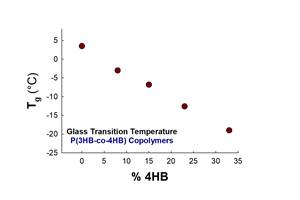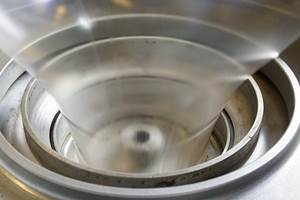Novel Air Ring Solves Gauge Variations for Film Processor
Crayex installs Addex gauge-controlling air ring built for rotating/oscillating dies on a problematic line and notices dramatic improvement in thickness variations.
“I would like three more, actually,” says David Harrison, plant manager for .’s operation in McDonough, Georgia, where it primarily makes shrink film. The “three more” he was referencing was the Gen 3 EGC Air Ring for rotating/oscillating dies from Addex, which Crayex installed on one of its four blown film lines last year to help correct gauge variations caused by a cranky die.
Crayex is a family-owned blown film processor that has been in ´óĎó´«Ă˝ since the 1970s. It has two plants: one in Piqua, Ohio, where the company has coextrusion capacity for shrink and other films; and one in Georgia which was opened in the 1980s and has strictly monolayer lines. While new blown film lines are typically sold with stationary dies, there are many blown film processors with rotating or oscillating dies in operation that need improved gauge control.
Crayex was one of them. Harrison and Mike Edwards, production manager for Crayex in Georgia, joined the company a day apart in 2022. And it didn’t take them long to realize that one of its four lines was underperforming. Says Harrison, “The line performed well when it was new and for years after, but over time one this line, we’d have difficulty managing the thickness profile. When I got here, it reached the point where our operators didn’t trust it. They had no confidence in it.” Harrison, Edwards and their team worked on fixes of their own to stabilize the line. And, as they recall, these would work for a short time — or even a few days — before the thickness variations returned.

Left to right, Crayex’s David Harrison, plant manager; Mike Edwards, production manager; and Gordon Smith, maintenance manager, in front of a fill line equipped with new Addex air ring for rotating/oscillating dies. Source (all images): Addex
Edwards, who had experience with Addex technology from another blown film producer, and by December of last year the new air ring was installed. Designed specifically for nonstationary dies, this air ring works much like Addex’s EGC gauge-controlling cousin for stationary dies, but with additional features. The EGC air ring, well known for its very high-resolution control, has a series of “fingers” that open or close to adjust localized air volume. A 300-mm/12-inch air ring, for instance, includes 168 control zones, with 200-plus control zones on larger systems.
This new rotating die-enabled technology is facilitated by a proprietary mapping algorithm embedded within Addex’s latest Gen 3 control technology that corrects for die rotation effects in real time. The new software/hardware system controls not only the auto-profile air ring but also simultaneously controls the physical rotation of the die.
Crayex saw the improvement immediately. Says Edwards, “It was night and day for us. It can’t correct everything that you make in a die. But we had an inherent gauge thickness on one portion of our die and this airing completely takes it away.”
Adds Harrison, “For a long time, we were unable to run certain products on that line. For instance, when we tried to run wider widths, one side of the roll would end up being too soft and the other too stiff and thick. This severely impacted our scheduling. We don’t have these problems anymore.”

Gauge-controlling air ring at Crayex features Addex’s single-inlet plenum design requiring just one hose.
The proof is in the numbers. According Harrison, the troublesome line generated scrap at a rate of 18-22%. Within the first two weeks after the EGC air ring was installed, amid what Harrison termed “a learning curve,” scrap was reduced to 15%. During the period Crayex spoke with Plastics Technology, the line was generating scrap at a rate of 6%. Notes Edwards, “We’ve also noticed that the faster we run the line, the quicker the air ring responds.”
Initially, the Addex EGC air ring installed at Crayex had a multiple-plenum design feeding eight hoses. Addex has since swapped that out with its single-inlet plenum design, which reduces the number of hoses delivering air to the unit from eight to one.
While Harrison, Edwards and their production group are comfortable with the way their three other lines are running, they see room for improvement and believe the Addex technology is a fit. Says Harrison, “There's a fit for this technology on every one of our lines. I would like to have three more actually.”
Related Content
Film Extrusion: Boost Mechanical Properties and Rate of Composting by Blending Amorphous PHA into PLA
A unique amorphous PHA has been shown to enhance the mechanical performance and accelerate the biodegradation of other compostable polymers PLA in blown film.
Read MoreFlexible-Film Processor Optimizes All-PE Food Packaging
Tobe Packaging’s breakthrough was to create its Ecolefin PE multilayer film that could be applied with a specialized barrier coating.
Read MoreReduce Downtime and Scrap in the Blown Film Industry
The blown film sector now benefits from a tailored solution developed by Chem-Trend to preserve integrity of the bubble.
Read MoreFollow These Tips to Fire Up Your Cold Blown Film Line
Firing up a cold blown-film line after a shutdown involves multiple pieces of equipment that all interact. Here’s a look at those components individually and some best practices on how to get your line up and running as quickly and safely as possible.
Read MoreRead Next
For PLASTICS' CEO Seaholm, NPE to Shine Light on Sustainability Successes
With advocacy, communication and sustainability as three main pillars, Seaholm leads a trade association to NPE that ‘is more active today than we have ever been.’
Read MoreLead the Conversation, Change the Conversation
Coverage of single-use plastics can be both misleading and demoralizing. Here are 10 tips for changing the perception of the plastics industry at your company and in your community.
Read More










